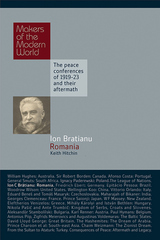

By mid-nineteenth century the movement for cultural and political self-determination of the Rumanians of Transylvania had attained a high degree of maturity and, at the same time, was entering a period of internal crisis. The Orthodox Church still stood at the center of national life, as it had for centuries, but now the paramount role of the clergy was effectively challenged by a dynamic class of lay intellectuals who were eager to set their people on a new, essentially secular, course to bring them abreast of the advanced nations of Europe.
The dominant figure of the period was Andreiu Şaguna, bishop and later metropolitan of the Rumanian Orthodox Church. Although he equaled the intellectuals in devotion to the national cause, he carried forward the venerable practices of ecclesiastical leadership and upheld the primacy of religion in the life of the nation. The tension he and the intellectuals created motivated Rumanian national development for nearly a quarter century.
The Rumanian experience has significance beyond the boundaries of Transylvania. Hitchins elucidates its connection to the complex process of national development that all the peoples of the Habsburg monarchy were undergoing, and suggests its relevance to contemporary Austrian policy toward national aspirations in general.

Long before Rumania existed as a sovereign state, Rumanians struggled for national identity in Transylvania, an area in Eastern Europe of great ethnic and cultural diversity. The growth of their national consciousness between 1780 and 1849 affords an intriguing case study in nationalism. Keith Hitchins gives us in this book the first systematic survey and analysis of the movement—its leadership, techniques, and literary and political manifestations.
Transylvania at that time was a principality in the Habsburg domain inhabited by four groups: Magyars, Szeklers, Saxons, and Rumanians. Through the centuries the region had frequently changed status—at times independent, more often dominated by either Hungary or Austria. In 1867 it became an integral part of Hungary. After the First World War it was annexed by Rumania (which had won its independence in 1878) and is Rumanian soil today.
Hitchins finds that in the late eighteenth and early nineteenth centuries, the national movement in Transylvania was led by Western-oriented Rumanian intellectuals, the majority of whom were Uniate and Orthodox priests or the sons of priests. Their principal weapons were their writings, the schools, and the church. Influenced by the Enlightenment, these men fashioned the goals of the movement and gave it its characteristic dimensions—its moderation, rationalism, and Western orientation. Through their emphasis on education and their own personal labors in the fields of Rumanian history and linguistics, they succeeded in creating a national ethos, without which political activity of any kind would have been fruitless and on which, later, more secularly-oriented national leaders could base their specific political demands.
Chronicling the changing course of the Rumanian struggle, the author shows that the nationalists began with a demand for the feudal rights enjoyed by their neighbors the Magyars, Szeklers, and Saxons, who were represented in the provincial diet and organized according to estates, or noble nations. Still reasoning within the context of a feudal constitution and thinking in terms of the historic principality, the Rumanians, who constituted a majority of the population of Transylvania, did not yet dare dream of a separate Rumanian nation in which they would be the dominant element. By 1849, however, they had come to regard the recognition of Rumanian autonomy within the Austrian Empire as the paramount issue and even looked toward the accretion of Rumanian-inhabited areas outside Transylvania to the grand duchy they hoped to see established. Ultimately, their goal became a union of all Rumanians, including the Kingdom of Rumania, in a modern national state.
READERS
Browse our collection.
PUBLISHERS
See BiblioVault's publisher services.
STUDENT SERVICES
Files for college accessibility offices.
UChicago Accessibility Resources
home | accessibility | search | about | contact us
BiblioVault ® 2001 - 2024
The University of Chicago Press









